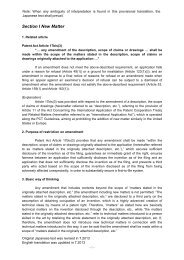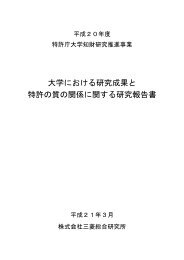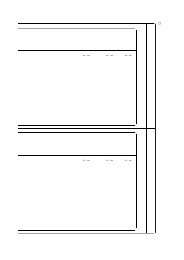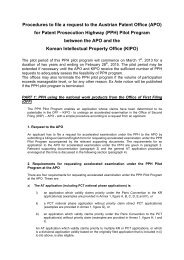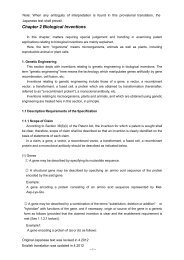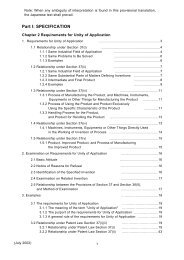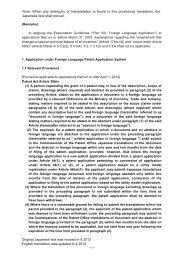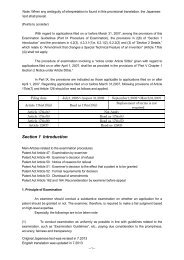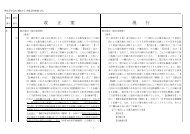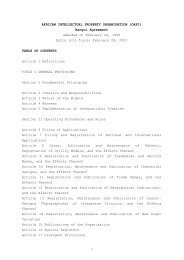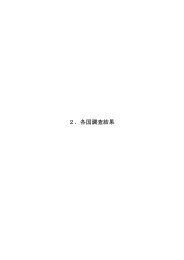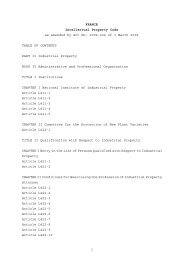Chapter 2 Novelty and Inventive Step - Japan Patent Office
Chapter 2 Novelty and Inventive Step - Japan Patent Office
Chapter 2 Novelty and Inventive Step - Japan Patent Office
You also want an ePaper? Increase the reach of your titles
YUMPU automatically turns print PDFs into web optimized ePapers that Google loves.
Part II <strong>Chapter</strong> 2 <strong>Novelty</strong> <strong>and</strong> <strong>Inventive</strong> <strong>Step</strong><br />
to that of the slot machine is an idea that would have been easily conceived by a person skilled in<br />
the art<br />
(Reference: Decision by the Tokyo High Court, June 24, 1997 [Heisei 8 (Gyo Ke) 103])<br />
[Example 2] A camera <strong>and</strong> an automatic strobe light are always used together <strong>and</strong> are<br />
closely related. Therefore, applying the incidence control element of a photometric circuit for the<br />
camera to a photometric circuit for the automatic strobe light would be an idea a person skilled in<br />
the art easily arrive unless any outst<strong>and</strong>ing structure is adopted for applying the element.<br />
(Reference: Decision by the Tokyo High Court, March 18, 1982 [Showa 55 (Gyo Ke) 177])<br />
[Example 3] The cited invention 1 <strong>and</strong> the cited invention 2 obviously belong to the same<br />
technical field since the cited invention 1 relates to the apparatus for collecting printing ink for<br />
corrugated cardboard printing machines <strong>and</strong> the cited invention 2 relates to the apparatus for<br />
supplying high viscosity liquids such as printing ink. The cited invention 2 provides an extremely<br />
basic technical means in which a transmit pump is composed of an emitting/aspiration pump<br />
convertible to normal/reverse turn by connecting a drive motor of the transmit pump to a reverse<br />
control circuit, which is a point to be incorporated to determine the difference between both of the<br />
cited inventions. Accordingly, the fact that a specific technical problem or purpose between these<br />
two cited inventions is not the same does not provide grounds to deny that the application of the<br />
technical means provided in the cited invention 2 to the cited invention 1 is an extremely<br />
conceivable idea to a person skilled in the art.<br />
(Reference: Decision by the Tokyo High Court, June 10, 1997 [Heisei 8 (Gyo Ke) 21])<br />
II. Close similarity of problems to be solved<br />
A close similarity found between problems to be solved in the inventions provides strong<br />
grounds for the reasoning that the claimed invention is an idea at which a person skilled in the art<br />
could arrive by applying or combining the cited inventions.<br />
[Example 1] Cited inventions 1 <strong>and</strong> 2 share the same problem to be solved: stopping the<br />
base sheet on which a label is temporarily attached at the predetermined position. The idea in the<br />
cited invention 1 of applying the controller for conveying labels in the cited invention 2 to solve the<br />
technical problem is at which a person skilled in the art could easily arrive.<br />
(Reference: Decision by the Tokyo High Court, July 27, 1991 [Heisei 2 (Gyo Ke) 182])<br />
[Example 2] The thickness of saw blades usually varies according to the length, <strong>and</strong> a person<br />
skilled in the art who read the cited invention 1 could easily predict the problem to be solved itself<br />
by exchanging blades with different levels of thickness on saws with changeable blades. In<br />
addition, it is apparent that clamping means in the cited inventions 4 – 7 provide clamping force to<br />
elastically clamp blades even with different thickness levels. And it is admitted that the structure<br />
itself is created based on the technical idea of clamping blades according to their various<br />
thickness levels, which shows that the idea of changing blades with different levels of thickness<br />
provided in the cited inventions 4 – 7 is similar to the problem to be solved by the claimed device.<br />
Accordingly, it should be said that a person skilled in the art can very easily arrive at a conversion<br />
of the elements of the cited inventions 4 – 7 to the elements of the ripsaw blade in the cited<br />
invention 1.<br />
(Reference: Decision by the Tokyo High Court, March 31, 1998 [Heisei 7 (Gyo Ke) 5])<br />
When the cited documents are not considered to be involved in the problem to be solved<br />
that is intended to be similar to the claimed invention, further analysis of the inventions based on<br />
19



